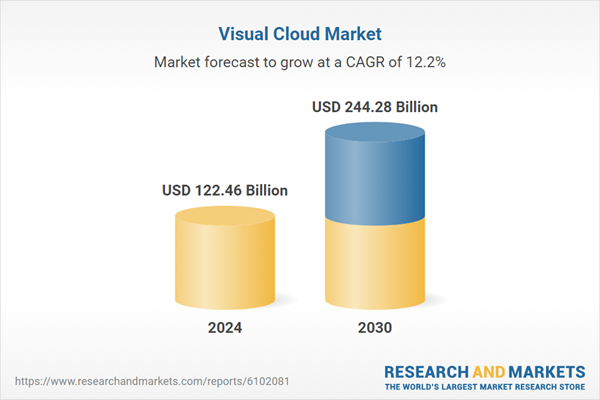Speak directly to the analyst to clarify any post sales queries you may have.
10% Free customizationThis report comes with 10% free customization, enabling you to add data that meets your specific business needs.
Key Market Drivers
Growing Demand for Real-Time Video Streaming and High-Definition Content Delivery
Rising consumption of high-definition and real-time video content across consumer and enterprise markets is a major factor accelerating the growth of the Visual Cloud Market. Services offering live events, gaming, remote collaboration, and streaming are demanding greater bandwidth and performance. Consumers increasingly expect ultra-HD content, including 4K and 8K video, delivered seamlessly across devices, pushing cloud providers to upgrade infrastructure with advanced visual computing capabilities. To meet these demands, providers are leveraging GPU-accelerated systems and edge computing frameworks that enhance video processing, ensure low-latency delivery, and support large-scale streaming operations.Key Market Challenges
High Infrastructure and Operational Costs Impeding Adoption
A key obstacle for the Global Visual Cloud Market is the high capital and operational investment required to support advanced visual workloads. Delivering real-time AR, VR, and high-definition video requires specialized hardware such as GPUs, expansive data storage, and powerful networking systems - raising costs significantly. This is especially burdensome for small and medium-sized enterprises and organizations in emerging economies, where budget constraints limit the adoption of sophisticated cloud infrastructures. Additionally, visual cloud environments generate high energy consumption and require complex cooling and maintenance systems, which contribute to escalating operational expenses. These financial and logistical hurdles slow market penetration and present scalability challenges for businesses aiming to expand their visual computing capabilities.Key Market Trends
Growing Adoption of Edge Computing to Enhance Visual Cloud Performance
One of the most notable trends in the Visual Cloud Market is the integration of edge computing to optimize performance and reduce latency. Visual applications like VR, AR, and real-time video require immediate data processing, which can be bottlenecked by centralized data centers. Edge computing mitigates this by positioning compute resources closer to users, enabling faster data handling and minimizing latency. This approach supports high-performance delivery for applications such as cloud gaming, immersive content, and live streaming. Moreover, edge solutions improve bandwidth efficiency by performing data pre-processing locally and reducing the load on central servers. The rise of 5G networks further enhances the potential of edge computing, and visual cloud providers are increasingly partnering with telecom firms to build scalable, low-latency infrastructure that supports next-generation use cases.Key Market Players
- Amazon.com, Inc.
- Microsoft Corporation
- IBM Corporation
- Cisco Systems, Inc.
- Oracle Corporation
- Adobe Inc.
- Intel Corporation
- Google LLC
Report Scope:
In this report, the Global Visual Cloud Market has been segmented into the following categories, in addition to the industry trends which have also been detailed below:Visual Cloud Market, By Offering:
- Solutions
- Services
Visual Cloud Market, By Deployment Type:
- Public Cloud
- Private Cloud
- Hybrid Cloud
Visual Cloud Market, By End Use:
- BFSI
- Media & Entertainment
- IT & Telecom
- Healthcare
- Retail & E-commerce
- Government & Public Sector
- Education
- Others
Visual Cloud Market, By Region:
- North America
- United States
- Canada
- Mexico
- Europe
- Germany
- France
- United Kingdom
- Italy
- Spain
- Asia Pacific
- China
- India
- Japan
- South Korea
- Australia
- Middle East & Africa
- Saudi Arabia
- UAE
- South Africa
- South America
- Brazil
- Colombia
- Argentina
Competitive Landscape
Company Profiles: Detailed analysis of the major companies present in the Global Visual Cloud Market.Available Customizations:
With the given market data, the publisher offers customizations according to a company's specific needs. The following customization options are available for the report.Company Information
- Detailed analysis and profiling of additional market players (up to five).
This product will be delivered within 1-3 business days.
Table of Contents
Companies Mentioned
- Amazon.com, Inc.
- Microsoft Corporation
- IBM Corporation
- Cisco Systems, Inc.
- Oracle Corporation
- Adobe Inc.
- Intel Corporation
- Google LLC
Table Information
| Report Attribute | Details |
|---|---|
| No. of Pages | 185 |
| Published | June 2025 |
| Forecast Period | 2024 - 2030 |
| Estimated Market Value ( USD | $ 122.46 Billion |
| Forecasted Market Value ( USD | $ 244.28 Billion |
| Compound Annual Growth Rate | 12.2% |
| Regions Covered | Global |
| No. of Companies Mentioned | 8 |









